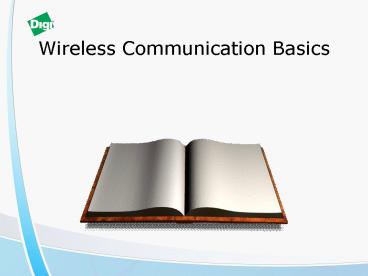Wireless Communication Basics PowerPoint PPT Presentation
1 / 32
Title: Wireless Communication Basics
1
Wireless Communication Basics
2
RF Basics
- Basic Communication System
- Transmitter and Receiver
3
RF Basics
- Basic Communication System
- Transmitter and Receiver
- Transmitting Antenna
4
RF Basics
- Basic Communication System
- Transmitter and Receiver
- Transmitting Antenna
- Receiving Antenna
5
RF Basics
- Basic Communication System
- Transmitter and Receiver
- Transmitting Antenna
- Receiving Antenna
- Environment
Environment
6
RF Basics
- Maximizing Range
7
RF Essentials
- Maximizing Range
- Increase Transmitter (TX) Power
- Government Regulated
- Low-powered Applications
8
RF Essentials
- Maximizing Range
- Increase Transmitter (TX) Power
- Increase Receiver (RX) Sensitivity
- Specified in dBm
- Every 6 dB doubles the range LOS
- Every 12 dB doubles range indoors / urban
environments
9
RF Basics
- Maximizing Range
- Increase Transmitter (TX) Power
- Increase Receiver (RX) Sensitivity
- Increase Antenna Gain
- More gain equates with more focusing of energy
- Antenna cables should be as short as possible
10
RF Basics
- Basic Communication System
- Transmitter and Receiver
- Transmitting Antenna
- Focused energy
11
RF Basics
- Basic Communication System
- Transmitter and Receiver
- Transmitting Antenna
- Receiving Antenna
- Focused energy
12
RF Basics
- Antenna Gain
- Government-imposed power restrictions
- Omnidirectional
13
RF Basics
- Antenna Gain
- Directional
14
RF Basics
- Maximizing Range
- Increase Transmitter (TX) Power
- Improve Receiver (RX) Sensitivity
- Increase Antenna Gain
- Clear the Environment of obstructions
- Visual (Linear) line-of-sight vs. RF (Radio)
line-of-sight
Clear the Environment
15
RF Basics
- Fresnel Zone
- Football-shaped path
16
RF Basics
- Fresnel Zone
- Football-shaped path
- Acceptable 60 of Zone 1 3 meters
- Raise antennas to help clear the zone
17
RF Basics
- Fresnel Zone
- Football-shaped path
- Acceptable 60 of Zone 1 3 meters
- Raise antennas to help clear the zone
- Formula
18
RF Basics
- Fresnel Zone Diameters
Range Distance 868 MHz Modems Required Fresnel Zone Radius 2.4 GHz Modems Required Fresnel Zone Radius
1 m 0,29 m 0,18 m
3 m 0,51 m 0,31 m
10 m 0,93 m 0,56 m
30 m 1,61 m 0,97 m
100 m 2,94 m 1,77 m
300 m 5,09 m 3,06 m
1600 m 11,76 m 7,07 m
8000 m 26,29 m 15,81 m
16000 m 37,18 m 22,36 m
19
Importance of Frequency Selection
- Geographic Deployment
- Worldwide versus Regional
- RF Performance
- Range
- RF Penetration
- Antenna Considerations
20
License-Free Bands
2.4 GHz
315 MHz 420 MHz 900 MHz 5.7 GHz
433 MHz 868 MHz 5.7 GHz
900 MHz
433 MHz
915 MHz
21
Regulatory Bodies
- FCC (United States)
- IC (Canada)
- ETSI (Europe, some APAC)
- C-Tick (Australia
- Telec (Japan)
- Anatel (Brazil)
22
Rates and Ranges
23
Nodes
Nodes and Rates
24
Radio Modem Operation
- Modem
- Modulate / Demodulate
25
Modulation
- What is modulation?
- The process by which a parameter (amplitude,
frequency or phase of a sinusoidal signal) of a
higher frequency carrier wave is altered in
accordance with the baseband message signal. - Transforms the message signal into a form that is
suitable for transmission over the channel. - The transmitter uses the baseband message signal
to modulate a carrier and transmit it over the
channel.
26
Radio Modem Operation
- Two types of spread spectrum used in modern
Radios - FHSS- Frequency Hopping Spread Spectrum
- Transmitter rapidly hops from one channel to the
next in a pseudo-random fashion, avoiding
long-term interference. - Receiver follows transmitter
- Some Digi Products use FHSS
- 24XStream
2400
2480
27
XStreamKey Features
- Price-to-Performance Value
- High Receiver Sensitivity
- Low Power Consumption
- FCC (U.S.A.), IC (Canada),
- ETSI (Europe) Approved
Best Value OEM RF Modules 2.4GHz
28
XStream (2.4 GHz)Best Value OEM RF Modules
Specifications Specifications
Indoor/urban Range up to 180 m
Outdoor line-of-sight Range up to 16 km
Transmit Power Output 50 mW (17 dBm)
Receiver Sensitivity -105 dBm _at_9600 bps
Operating Frequency 2.45-2.46 GHz
Operating Voltage 5V (OEM) 7-18 (Boxed)
RF Data Rate 9600 or 19200 bps
Interface Packages Available
29
Radio Modem Operation
- Two types of spread spectrum used in modern
Radios - DSSS- Direct Sequence Spread Spectrum
- Each bit is represented by N, shorter segments,
called chips. - Increases over-the-air rate by a factor of N,
widening the spectrum - Correlator in receiver examines the chips and
maps chips back to bits, while simultaneously
spreading undesired signals - Processing gain, 10log(chip_rate/bit_rate)
- Some Digi productsuse DSSS
- XBee
- XBee-Pro
- All WiFi enabledproducts
30
Digi RF Products
Packaged (Boxed)
Modules (Embedded)
31
DigiRF Products
- XBee
- XStream
- XTend
- XPress
- XCite
- Digi Mesh
32
Digi RF Modules
Product Name Frequency Power Output Indoor RangeOutdoor Range Data Rate
XBee 2.4 GHz 1 mW 30 meters100 meters 250 Kbps
XBee-PRO 2.4 GHz 10 mW 19 mW (EIRP) 80 meters800 meters 250 Kbps
9XTend 900 MHz 1 Watt 900 meters64 kilometers 115 Kbps
9XStream 900 MHz 100 mW 450 meters32 kilometers 19.2 Kbps
24XStream 2.4 GHz 50 mW 180 meters16 kilometers 19.2 Kbps
9XCite 900 MHz 4 mW 90 meters300 meters 38.4 Kbps

